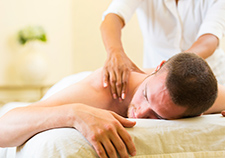Office of Research & Development |
 |
Office of Research & Development |
 |

VA Research Currents archive
July 1, 2015
By Mitch Mirkin
VA Research Communications

Veterans with osteoarthritis of the knee benefited from Swedish massage in a VA-Duke University pilot study. (Photo: ©iStock/Steve Debenport)
Put down the pill bottle—get a massage instead.
Lots of people with arthritis pain would be happy to hear this advice from their doctor. But researchers are still testing the benefits of this therapy with ancient roots—whom it helps, for what conditions.
Now, good news from a team at Duke University and the Durham (N.C.) VA Medical Center. They showed in a small pilot study that Swedish massage is an acceptable and feasible treatment for VA health care users with osteoarthritis of the knee. Moreover, the Veterans who took part in the study reported, on average, about a 30 percent improvement in pain, stiffness, and function.
The study appears in the June 2015 Journal of Alternative and Complementary Medicine.
Dr. Adam Perlman of the Duke Integrative Medicine Center, working with VA colleagues, led the trial, involving 25 Veterans. The group was mostly men, whites and African Americans, with an average age of 57, and an average BMI of around 32, which is above the obesity threshold.
Perlman led an earlier clinical trial that found the therapy effective for knee osteoarthritis in a general population. But he wanted to put Swedish massage to the test for VA patients.
For one thing, most VA patients are men, who as a group might be somewhat less receptive than women to the idea of massage. Think about who typically goes to spas.
Second, VA patients are more likely than the general population to have multiple health problems—physical or mental. This could complicate how massage is delivered, or its effects.
As it turns out, the idea of Swedish massage sat well with the Veterans in the study.
Almost all of those who started the study—23 out of 25—completed the eight weekly one-hour massage sessions, given at Duke Integrative Medicine, about a mile from the Durham VA. More than 90 percent of them said they wanted to continue to receive massage as part of their arthritis treatment plan. Nearly 90 percent said they thought other Veterans would try massage if it were offered in VA.
Dr. Kelli Allen, a VA health services researcher who worked on the study, says recruiting a diverse mix of VA arthritis patients for the study posed no particular challenge.
"We had comparable rates of recruitment, among eligible participants, as those we have seen in clinical trials of other behavioral and lifestyle interventions among Veterans with osteoarthritis. That was an important aspect of feasibility for us to assess in a pilot study. Our experience suggests there is indeed interest in massage therapy among VA health care users."
Swedish massage, introduced in the U.S. in the mid-1800s, generally uses a whole-body approach, working all the major muscle groups. Therapists apply firm but gentle pressure to compress and relax muscles, boosting circulation. Patients are typically draped with a sheet, but they can opt to wear clothes during the treatment and have only certain areas worked on.
"Massage need not be full-body, but often is," says Perlman. "Massage therapists see different parts of the body as being connected, and therefore one might massage the foot as part of an approach to helping someone with low back pain."
Notwithstanding the encouraging pain results, participants didn't show much improvement in one measure in the study: a timed 50-foot walk.
"We're still learning about the effects of massage for those with knee osteoarthritis—the different benefits, and the outcomes it may impact the most," explains Allen. "Regarding the walking test, there are many factors that could affect the results, such as muscle endurance and cardiovascular function. So it's not overly surprising that the results on this test, though improved, were not significantly different from baseline."
She says it could be that further gains would be seen with continued treatment. "It's possible that over time, massage therapy would help patients improve their walking ability even more. If their pain were reduced, they might be able to maintain greater daily physical activity, and therefore build muscle strength and function."
Speaking of pain, the researchers say it's not clear whether massage could eliminate the need for medication. But used as an adjunct treatment, it could conceivably reduce the need.
"Even being able to reduce pain medication use would be a highly valued outcome for many patients," notes Allen. "We know from our prior studies among Veterans with osteoarthritis that many would like to reduce reliance on medications for many reasons, including side effects and the possibility of longer-term risks."
Allen says the group plans to conduct a larger clinical trial, and to also explore whether Veterans could do self-massage at home to help manage their arthritis.